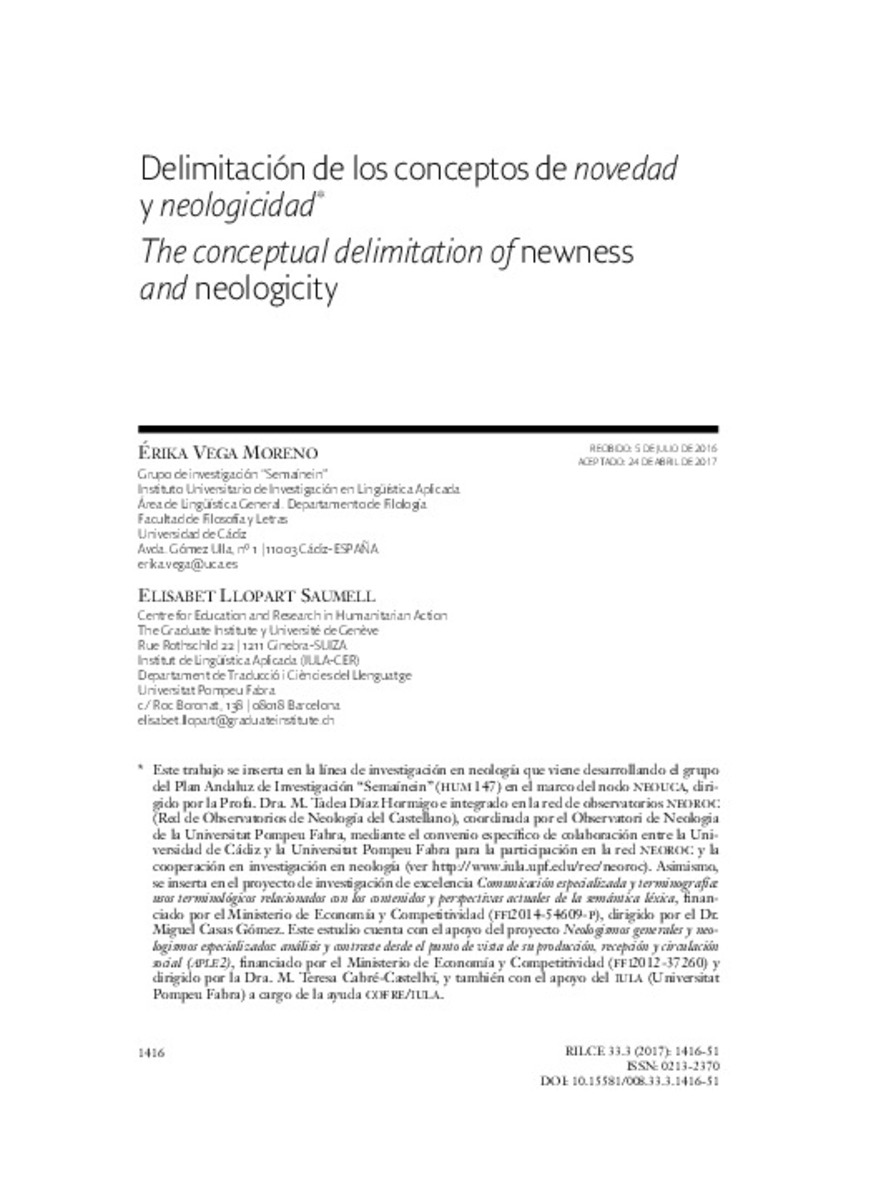Full metadata record
| DC Field | Value | Language |
|---|---|---|
| dc.creator | Vega-Moreno, E. (Érika) | - |
| dc.creator | Llopart-Saumell, E. (Elisabet) | - |
| dc.date.accessioned | 2018-06-11T10:23:06Z | - |
| dc.date.available | 2018-06-11T10:23:06Z | - |
| dc.date.issued | 2017 | - |
| dc.identifier.citation | Vega Moreno, Érika; Llopart-Saumell, E. (Elisabet). "Delimitación de los conceptos de novedad y neologicidad". Rilce. Revista de Filología Hispánica. 33 (3), 2017, 1416 - 51 | es |
| dc.identifier.issn | 0213-2370 | - |
| dc.identifier.uri | https://hdl.handle.net/10171/53125 | - |
| dc.description.abstract | El objetivo de este estudio consiste en profundizar en las nociones de novedad y neologicidad con el fin de aislar las propiedades que contribuyen a la caracterización de la cualidad de neológico. En concreto, partimos de la idea de que el criterio lexicográfico, aunque proporciona una metodología sistemática y coherente, ofrece resultados limitados porque, de acuerdo con la percepción del hablante, algunas de las unidades identificadas como neológicas no se considerarían como tales. Por este motivo, en el marco de las tesis doctorales presentadas en el ámbito de la neología, proponemos un enfoque teórico para el estudio de estos conceptos y, a continuación, planteamos un análisis aplicado a partir de un conjunto más amplio de criterios. Las observaciones anotadas en este trabajo muestran que, efectivamente, las nociones analizadas son relevantes para avanzar en la delimitación del concepto de neologismo y contribuir, de esta forma, en la investigación actual en neología. | - |
| dc.description.abstract | Neology is a field of knowledge devoted to the study of new lexical units that appear in a particular language in a specific period of time. In order to identify its object of study, which is the neologism, the lexicographical criterion is the most widely-used parameter, because it provides a coherent and systematic methodology. However, the results obtained with this criterion show some limitations, such as the fact that, according to speakers’ perception, some units identified as neological are not considered new. For this reason, the aim of this article is to carry out an in-depth study of the concepts of newness and neologicity in order to detail the properties that contribute to the characterization of neological units. First of all, we propose a theoretical approach in order to develop, subsequently, an applied analysis using a greater number of criteria. The recorded observations show that the notions analysed are, in effect, relevant to the improvement of the delimitation of the concept of neologism and contribute considerably to neology research. | - |
| dc.language.iso | spa | - |
| dc.publisher | Servicio de Publicaciones de la Universidad de Navarra | - |
| dc.rights | info:eu-repo/semantics/openAccess | - |
| dc.subject | Neología | - |
| dc.subject | Neologismo | - |
| dc.subject | Neologicidad | - |
| dc.subject | Novedad | - |
| dc.subject | Creatividad léxica | - |
| dc.subject | Formación de palabras | - |
| dc.subject | Neology | - |
| dc.subject | Neologism | - |
| dc.subject | Neologicity | - |
| dc.subject | Newness | - |
| dc.subject | Lexical creativity | - |
| dc.subject | Word-formation | - |
| dc.title | Delimitación de los conceptos de novedad y neologicidad | - |
| dc.title.alternative | The conceptual delimitation of newness and neologicity | - |
| dc.type | info:eu-repo/semantics/article | - |
| dc.identifier.doi | 10.15581/008.33.3.1416-51 | es_ES |
| dadun.citation.endingPage | 51 | - |
| dadun.citation.number | 3 | - |
| dadun.citation.publicationName | Rilce. Revista de Filología Hispánica | - |
| dadun.citation.startingPage | 1416 | - |
| dadun.citation.volume | 33 | - |
| dc.date.updated | 2018-06-11T10:23:06Z | - |
| dc.description.version | Peer Reviewed | - |
Files in This Item:
Statistics and impact
Items in Dadun are protected by copyright, with all rights reserved, unless otherwise indicated.






